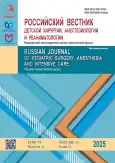Хирургическое лечение детей с тяжелыми повреждениями стопы
- Авторы: Дюков А.А.1, Стальмахович В.Н.1,2, Рудаков А.Н.1, Тещук Р.А.1
-
Учреждения:
- Детская областная клиническая больница
- Иркутская государственная медицинская академия последипломного образования
- Выпуск: Том 15, № 2 (2025)
- Страницы: 279-290
- Раздел: Клинические случаи
- URL: https://journal-vniispk.ru/2219-4061/article/view/313010
- DOI: https://doi.org/10.17816/psaic1901
- EDN: https://elibrary.ru/VBYQTR
- ID: 313010
Цитировать
Полный текст
Аннотация
Размозжение конечности — тяжелая травма, возникающая в результате грубого механического воздействия, при этом определяется повреждение всех тканей пораженного сегмента. Для достижения наилучших результатов лечения применяется индивидуальный подход с привлечением специалистов различных профилей: травматологов, хирургов, реабилитологов, анестезиологов и реаниматологов. В работе представлены два клинических наблюдения хирургического лечения детей с размозжением стопы и наличием обширного дефекта мягких тканей. Нами выделены основные этапы диагностики, обсуждаются принципы выбора и планирования оперативного вмешательства. После проведенной некрэктомии и репозиции костных отломков, с целью замещения дефекта мягких тканей применяли различные пластические методики: с использованием местных тканей, свободными аутотрансплантатами и полнослойная кожная пластика на питающей ножке. В статье описана динамика заживления дефектов, анализируются результаты проведенных оперативных вмешательств. Фотографии демонстрируют этапы до и после хирургических вмешательств. Результат проведенных этапных оперативных вмешательств — сохранение конечности, консолидация костей с допустимым смещением отломков, устранение дефекта мягких тканей и восстановление функции нижней конечности. Представленные клинические наблюдения демонстрируют сложность и необходимость междисциплинарного подхода в лечении пациентов с размозжением стопы.
Ключевые слова
Полный текст
Открыть статью на сайте журналаОб авторах
Андрей Анатольевич Дюков
Детская областная клиническая больница
Email: duk.hir@mail.ru
ORCID iD: 0000-0001-6007-1298
канд. мед. наук
Россия, ИркутскВиктор Николаевич Стальмахович
Детская областная клиническая больница; Иркутская государственная медицинская академия последипломного образования
Email: stal.irk@mail.ru
ORCID iD: 0000-0002-4885-123X
SPIN-код: 9042-5092
д-р мед. наук, профессор
Россия, Иркутск; ИркутскАлексей Николаевич Рудаков
Детская областная клиническая больница
Email: stalker_38@mail.ru
ORCID iD: 0000-0002-3062-1575
Россия, Иркутск
Роман Андреевич Тещук
Детская областная клиническая больница
Автор, ответственный за переписку.
Email: teschuk@yandex.ru
ORCID iD: 0009-0007-4069-2258
SPIN-код: 9273-8109
Россия, Иркутск
Список литературы
- Ahuja PR, Akhuj A, Yadav V, et al. Managing complex foot crush injuries: A case report. Cureus. 2024;16(1):e52572. doi: 10.7759/cureus.52572
- Radwan MS, Mashal AA. The application of posttransfer free flap expansion for management of severe foot crush injury with extensive soft tissue loss: A case report. Plast Reconstr Surg Glob Open. 2020;8(3):e2707. doi: 10.1097/GOX.0000000000002707
- Shibayev EY, Ivanov PA, Nevedrov AV, et al. Tactics of treatment for posttraumatic soft tissue defects of extremities. Russian Sklifosovsky Journal “Emergency Medical Care”. 2018;7(1):37–43. doi: 10.23934/2223-9022-2018-7-1-37-43 EDN: YWSCGX
- Khan MM, Cheruvu VPR, Krishna D, et al. Post-traumatic wounds over the dorsum of the foot — our experience. Int J Burns Trauma. 2020;10(4):137–145.
- Mitish VA, Medinskiy PV, Bagaev VG, et al. Surgical treatment of a teenager with an extensive wound defect of soft tissues against the background of severe combined injury. Russian Journal of Pediatric Surgery, Anesthesia and Intensive Care. 2024;14(2):241–256. doi: 10.17816/psaic1805 EDN: KASMFA
- Pyatakov SN, Zavrazhnov AA, Fedosov SR, Shevcheko AV. Application of dosed dermotension for closure of wound defects of soft tissues of the lower leg of purulent-narcotic and traumatic origin. Bulletin of Pirogov National Medical and Surgical Center. 2012;7(3):60–63. (In Russ.) EDN: RPCFEL
- Pyatakov SN, Bensman VM, Baryshev AG, et al. Application of dosed tissue stretching for skin and tissues defects of upper limbs. Medical news of the North Caucasus. 2017;12(4):390–393. doi: 10.14300/mnnc.2017.12110 EDN: YXJORM
- Gopal S, Giannouds PV, Murray A, et al. The functional outcome of severe, open tibia fractures managed with early fixation and flap coverage. J Bone Joint Surg Br. 2004;86(6):861–867. doi: 10.1302/0301-620x.86b6.13400
- Abalmasov KG, Chichkin VG, Garelik YeI, et al. Primary plastic repair of extensive extremity defects with vascularized flaps. Russian Journal of Surgery. 2004;(6):47–53. EDN: OIVWTP
- Bogov AA, Ibragimova LYa, Mullin RI, et al. Vascularized skin and soft tissue plastic by axial flaps in treatment of patients with combined shin and foot injuries. Review. Modern problems of science and education. 2013;(1):28. EDN: PWAWYB
- Bottini GB, Gaggl A, Steiner C, Bürger HK. The fasciocutaneous iliotibial band perforator flap in soft tissue and tendon reconstruction of the foot: A case report. Microsurgery. 2020;40(3):395–398. doi: 10.1002/micr.30545
- Zelenin VN, Kuklin IA, Popov IV, Afanasov VA. Application of grafts with axial bloodstream for therapy of wounds and replacement of tissue defects. Bulletin of the East Siberian Scientific Center SB RAMS. 2005;(3):222–223. EDN: KZZJHX
- Polyakov AV, Bogdanov SB, Savchenko YP, Fomenko OM. Relevance of the tube flap use in the surgical treatment of patients with wounds and cicatricial deformities of skin. Kuban Scientific Medical Bulletin. 2018;25(1):111–116. doi: 10.25207/1608-6228-2018-25-1-111-116 EDN: OZOJJH
- Matchin AA. 100 years stalked dermepenthesis method by VP Filatov. Bulletin of Pirogov National Medical and Surgical Center. 2016;11(4):120–122. EDN: XVRTTP
- Fisthal EhYa. Wound process and results of early surgical treatment of extensive RAS — a perspective on the problem. Bulletin of urgent and recovery surgery. 2016;1(2):156–163. (In Russ.) EDN: XICOED
Дополнительные файлы






















